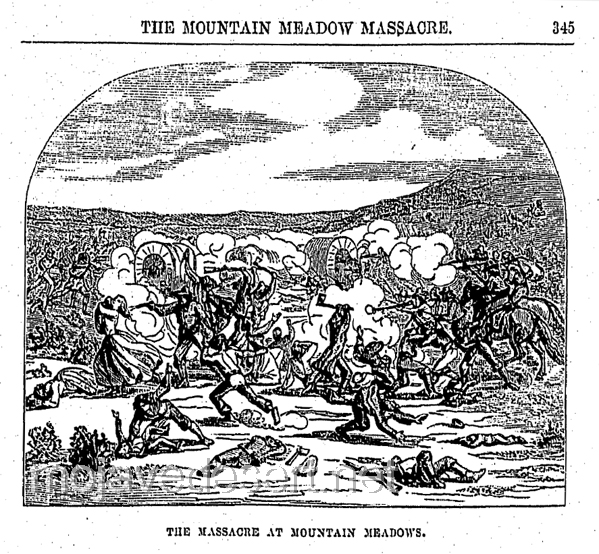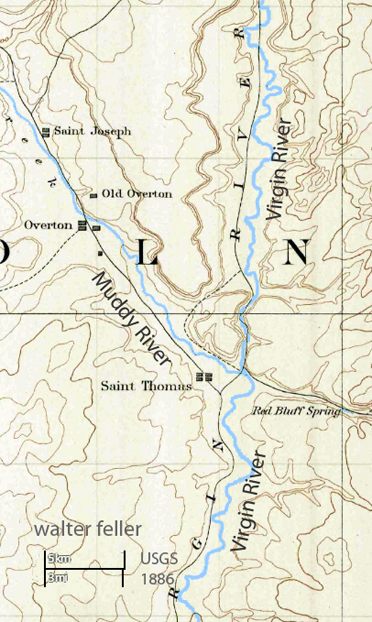The Mormon War
The Mormon War, or Utah War, of 1857–58 was not a shooting war, although it came perilously close to becoming one. Brigham Young, the spiritual leader of the Mormons, also served as the Utah territorial governor, which is contrary to the American policy of separation of church and state. When President Buchanan receive reports of alleged favoritism of church laws over U.S. laws, he appointed a new governor and other public officials to the territory. Fearing that his newly appointed officials would be met with opposition, he dispatched to Utah a large military force under the command of Colonel Albert Sidney Johnston to force compliance. Governor Young reacted to this challenge by declaring martial law, mobilizing the militia, and recalling all Mormons living in other parts of the West back to Utah to help defend the Mormon homeland. Colonel Johnston’s military force was delayed in its march to Utah by winter weather. The delay gave time for tempers to cool and the dispute was settled by negotiation.
Mormon Fort - Las Vegas, Nevada
Another factor which might have influenced many emigrants in 1858 to travel another route than the Oregon-California Trail was the Mountain Meadows Massacre, the news of which reached the East in the early spring of that year. [1]

There were several reasons for Mormon interest in the lower Colorado. The State of Deseret, an empire unto itself, was growing rapidly by immigration and natural increase, and the long transcontinental trek was a hardship and hazard; especially, given the continuing hostility that was harbored in the East. An outlet to the sea could perhaps offer the Saints easier access to their Great Basin haven. Furthermore, commerce and investments beyond the seas were contemplated, among them plantations of sugar cane on the Hawaiian islands.
Additionally, the region of the river was inhabited by Lamanites among whom missionary work was needed. Later, as real and imagined hostility between Deseret and the States intensified, a threat from the south was perceived and, of course, substantiated by the rumors about Ives.
As early as 1855 a mission was established at Las Vegas Springs. From that place, Rufus Allan was called by Brigham Young to explore the river below Vegas Wash and to determine its navigability. They travelled downstream, but were forced away from the river at the head of Black Canyon. At that point, judging from the smooth flow of the current, they deemed the river to be navigable. The expedition traversed the west side of the river, probably as far as Eldorado Canyon from which they returned to Las Vegas.
In 1856 several Vegas missionaries searched in the other direction to take a census of the Indians and inventory of resources. From Vegas Wash the group, as before with an Indian guide, went upriver to Boulder Canyon at which point they went cross country to the Virgin River, thence up the Muddy and back to Vegas. By this time the Mormons had explored the areas near the Colorado but had never been on the river itself. Their 1855-1856 reports to Brigham Young on the navigability of the river were not optimal.
In 1857, the Mormons understandably sensitive as a result of the brutal treatment that they had received at Nauvoo as well as other harassment, and learning of Ives' land and river thrusts up from the Gulf, were nervous and needed to acquire intelligence. The military authorities, for their part, felt that they had reason to believe that the Mormons were inciting the Indians against them.
Lt. James White, with some troopers, was sent north with Johnson to investigate. Although real dangers were encountered, the stage was set for a comic opera.
Jacob Hamblin at that time, shortly following the Mountain Meadow Massacre, was escorting Gentile wagon trains along the old Spanish trail. In response to the rumors of invasion, he dispatched two of his missionaries, Ira Hatch and Dudley Leavitt, to the Colorado tribes in December of 1857. In Cottonwood Valley, the men with their Paiute guides, were captured by Mojaves and, trapped in the rear of a wickiup, found themselves condemned to death. Their bravery and prayer, impressed the Mojave chief who allowed them to leave.
Shortly thereafter, Hamblin took Thales Haskell, Levitt, and Knight on another reconnaissance. On seeing the Explorer, they determined to send Haskell on board as a spy with a concocted story about a new route to California to avoid Indian depredations. The other three were to remain in hiding. They did not know their horses' hoof prints had been seen or that Haskell would be recognized by troopers who had seen him in Salt Lake City. On board the Explorer, Haskell was told of the true purpose of the voyage, but was not thoroughly convinced. Ives interrogated Haskell about Mormon intentions, "and was assured they would not interfere with his explorations, as they were fully occupied in the north and east.
After further investigation during which he saw soldiers and rockets being fired, Hamblin felt confirmed in his suspicions of an invasion. He prudently returned to Vegas. As a result, a third expedition was mounted in April 1858 under the leadership of Apostle Amasa M. Lyman. This expedition was expressly to determine the limits of navigation and a location for a defensive site. After leaving Las Vegas, the group went through Railroad Pass, El Dorado Valley, Cottonwood Canyon, and finally to Pyramid Canyon from which they were able to identify a good site for defense. This, despite the rockets, proved unnecessary. As far as navigation was concerned, they reported that Eldorado Canyon seemed to be a feasible limit.[2]
1. From: Notes: Chapter 1 - Disaster at the Colorado
2. Adapted from: HISTORIC RESOURCES STUDY LAKE MEAD NATIONAL RECREATION AREA, NEVADA
by Mike Belshaw, Principal Investigator and Ed Peplow, Jr.,
Mining Study - 1980
Mormons Recalled to Utah

